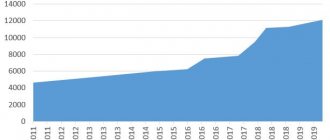What types of remuneration systems are there and when are they used?
For each group of workers in an enterprise and even for each specific person, the payment system for performing labor functions may vary. Let us highlight the following types of such systems:
- Time-based - an employee’s payment is directly dependent on the time he or she works. In this case, the employee is set an hourly or tariff rate and salary.
- Piecework - the amount of earnings depends on the amount of work performed. Piece rates must be approved here.
- Commission - when it is established, the employee receives a commission (percentage) on a certain indicator, for example, 5% of the store’s daily revenue.
- Variable salary system - an employee's salary is subject to periodic review, for example once a quarter or month. Such a review can be influenced by such an indicator as the completion of the planned amount of work.
- Chord - involves establishing a relationship between the amount of an employee’s salary and the package of work he performs in accordance with the chord assignment for a specific period.
The payment system is approved either in a local regulatory act at the enterprise, for example in the regulations on remuneration, or in a collective or labor agreement.
If you have access to ConsultantPlus, go to the Ready Solution and find out the features of payroll calculation in each wage system. If you do not have access to the legal system, get a trial demo access for free.
How to calculate
Let's consider 2 calculation options: for 40 and 24 hours of work per week. To calculate the hourly tariff rate from the hourly salary, the formula is used:
Example 1: 40 hours per week.
Let’s say a proofreader at a publishing house works 5 days a week, 8 hours a day.
Salary - 20,000 rubles per month.
The number of working hours in 2022 at 40 working hours per week is 1970.
Hourly tariff formula: 20,000 × 12 /1970 = 121.82 rubles.
Example 2. 24 hours a week.
A 15-year-old teenager works as a courier for a publishing house.
Salary - 15,000 rubles per month.
The number of working hours in 2022 with a 24-hour work week is 1179.6.
Formula for calculating the hourly tariff rate for 2022: 15,000 × 12 / 1179.6 = 152.5 rubles.
What is hourly wages and what are its forms?
The hourly wage system is one of the varieties of the time-based system. Here, wages are calculated depending on the amount of time worked - hours - and the established hourly rate.
NOTE! With a time-based system, salaries or tariff rates may also be set, but these are usually tied to a month.
At enterprises, depending on the specifics of production and other factors, the hourly system can take the following forms:
- Standard hourly rate - when a fixed rate is set for one hour of work. At the same time, the volume and quality of work do not affect wages. This form is typical for the positions of security guard, operator, administrator, etc.
- Premium hourly wage - here the volume and quality of work performed will affect wages. That is, the time worked is paid and to this amount is added the amount of the bonus, the amount of which must be indicated in the regulations on remuneration, employment contract or in other regulations or agreements.
- Standardized hourly rate - in this case, in addition to the hourly rate, an additional payment is guaranteed for strict compliance with the conditions established by the employer. This form is convenient to use when exceeding production standards is undesirable.
What is an hourly minimum wage?
Deputies proposed a bill for consideration, according to which, from January 1, 2022, the minimum hourly rate (MRHW) will be determined. This change will increase the incomes of citizens and bring their wages to the level of developed countries.
According to the draft law, the initial value of the hourly minimum wage is planned to be set at 150 rubles. Subsequently, this value of the indicator will be annually indexed to the amount of inflation based on the results of the previous year.
There was an option to determine the hourly minimum wage based on the current minimum wage, but it was rejected because:
- the number of working hours in each month is different, and a monthly change in the hourly rate is not convenient or advisable;
- the hourly rate determined on the basis of the minimum wage is considered too low. For example, if the minimum wage is 12,130 rubles, then the cost of an hour in May with 135 working hours will be 89.85 rubles. (12,130 / 135), and in July with 176 working hours - 68.92 rubles. (12,130 / 176).
If the hourly rate is set at a fixed rate of 150 rubles, then the employee will receive more wages. For example, in May it will be equal to 20,250 rubles. (150 * 135), and in July - 26,400 rubles. (150 * 176).
When is hourly wages beneficial?
The benefit for employers when setting hourly wages is obvious: they only have to pay for the time worked. This type of payment is especially popular for those employees who do not work full time. Examples include:
- workers with an uneven workload involved in performing work at a specific facility;
- workers whose working hours cannot be regulated (for example, teachers who teach additional classes in educational institutions);
- employees employed on a flexible schedule;
- workers whose labor productivity is very difficult to determine.
However, this system has certain disadvantages. For example, in the absence of bonus payments, employees are usually not interested in working faster and more, i.e. production efficiency decreases. In addition, the employer needs to monitor every hour the employee works, which may require an additional employee to keep track of time, leading to new costs.
How hourly wages are reflected in the staffing table - sample
The staffing table is an internal document of the company, which collects all the information about the personnel structure, composition and number of employees, as well as the monthly payroll. When an employee is hired on an hourly basis, the staffing table must contain a corresponding note about this.
If we take as a basis the unified form T-3, put into circulation by Decree of the State Statistics Committee of the Russian Federation dated January 5, 2004 No. 1, the hourly rate should be indicated in column 5 “Tariff rate (salary), etc., rubles,” and in column 10 “Notes » register “Hourly wages” with reference to the normative act establishing the payment system.
Use the link below to see how the staffing table is drawn up for those employees for whom the hourly form is approved.
Minimum size
The legislation does not establish a minimum hourly wage rate in 2022. But when calculating it, it is necessary to take into account the following: the minimum monthly salary of an employee who has worked the full working time cannot be lower than the minimum wage. From January 1, 2019, the federal minimum wage is 11,280 rubles. It is obvious that the hourly wage rates of workers for 2022 will not be lower than those calculated from the minimum wage.
The hourly tariff rate from the minimum wage for a 40-hour work week is calculated using the formula:
If a regional minimum wage has been established in the region where the organization operates, the company should focus on it. For example, in Moscow the minimum wage is 20,195 rubles, and in St. Petersburg - 18,000 rubles.
What features need to be taken into account in an employment contract for hourly wages - sample
When employing an employee, all aspects relating to the calculation and payment of wages are usually discussed between him and the employer, which must then be formalized in writing by signing an employment contract. In it (or an additional agreement to it), the Labor Code obliges to prescribe the conditions for hourly wages, if one is established for the employee.
NOTE! When transferring employees to hourly pay from another salary system, the employer must notify them of this no later than 2 months before introducing the planned changes. Such changes, by the way, should be reflected in orders and other regulatory documents of the organization.
It is advisable to stipulate in the employment contract:
- the amount of the hourly wage rate (salary);
- tariff category;
- the procedure for calculating wages for the month;
- bonus conditions;
- terms of payment for holidays, weekends and night hours;
- deadlines for issuing wages;
- other conditions, which may include a probationary period, social guarantees, etc.
Download a sample extract from an employment contract regarding the establishment of an hourly wage system and hourly rate from the link below.
Results
Hourly wages are one of the types of time-based systems, when, to calculate wages for each specific employee, a rate is set for one hour of work and the number of hours worked is calculated. In this case, the rate should be such that when working out the monthly quota, the employee is accrued no less than the minimum wage, which in 2022 is equal to 12,792.00 rubles.
All conditions relating to the calculation and payment of wages under the agreed system are included in the text of the employment contract or local regulations of the company. That is, the employee must be familiar with the principles on which his monthly earnings are calculated.
Sources: Labor Code of the Russian Federation
You can find more complete information on the topic in ConsultantPlus. Free trial access to the system for 2 days.
Payroll calculation procedure
If the enterprise uses a salary calculation system, then the salary of a particular employee is calculated using the formula C = O * Chf / Chn, where O is the monthly salary, Chn is the number of working hours in a given month according to the norm, Chf is the number of hours actually worked.
First you need to determine the norm of working hours per month using the formula Chn = N * Dm / Dn – Chp, where Dm is the number of working days in a given month, Dn is the number of working days in a week, and N is the length of the working week in hours, which is determined by the working hours contract and is limited to 40 hours (Article 91 of the Labor Code of the Russian Federation), and for certain professions the working week can be shortened - for example, for teachers the working week lasts 36 hours.
Chp – the number of pre-holiday days in a given month, since the pre-holiday shift lasts an hour shorter. When calculating the number of emergency situations, you need to take into account holidays in the next billing month, for example, there are no public holidays in April, but the working day on April 30 will be shortened by an hour due to the upcoming May holidays.
Example 1 . The employee has a monthly salary of 20,000 rubles and a standard five-day working week; in February, the employee took half a shift (4 hours) at his own expense twice. In February there are 20 working days and one pre-holiday, which means that the number of working hours according to the norm is 40 * 20 / 5 – 1 = 159 hours. The number of hours actually worked is less than the norm by 2 * 4 = 8 hours. The salary is 20,000 * (159 – / 159 = 18,993.71 rubles.
Hourly payment
If a time-based tariff payment system is used, then to calculate wages by the hour, the formula C = Tch * H is used, where Tch is the tariff rate per hour of work in rubles, H is the number of hours worked in a given month. Time-based payment in its pure form is rarely used; in most cases, enterprises introduce bonuses, which are reduced for reducing the number of hours worked below the norm (for example, due to absenteeism) and increased during overtime.
It is important to note that the rate for overtime during the first two hours after the end of the shift must be at least 150% of the basic rate, and for overtime over 2 hours - at least 200% of the base rate for each hour of overtime starting from the third. The rate for work on weekends and holidays is also 200% of the basic hourly rate.
The rate for night shifts from 10 p.m. to 6 a.m. must be at least 120% of the standard rate, according to Government Resolution No. 554.
Example 2 . The tariff rate of a watchman working according to the railway schedule is 150 rubles per hour. In February, the employee was late after his shift 2 times - once for an hour, another time for 3 hours. The number of shifts for February is 14, of which 7 are night shifts. The night shift lasts from 20.00 to 8 am, including an hour break for lunch.
The number of daily working hours according to the norm : 7 * 11 + 7 * 4 = 77 + 28 = 105 hours (of which 28 hours are part of the night shifts, not included in the period from 22 to 6 am). Number of night working hours according to the norm: 7 * 7 = 49. Number of hours at the rate of 150% - 3 hours, at the rate of 200% - 1 hour.
The salary is:
150 * 105 + 150 * 49 * 120% + 150 * 3 * 150% + 150 * 1 * 200% = 15750 + 8820 + 675 + 300 = 25545 rubles.
It is necessary to take into account that the employer will withhold a tax of 13% from the final calculated monthly salary amount.






